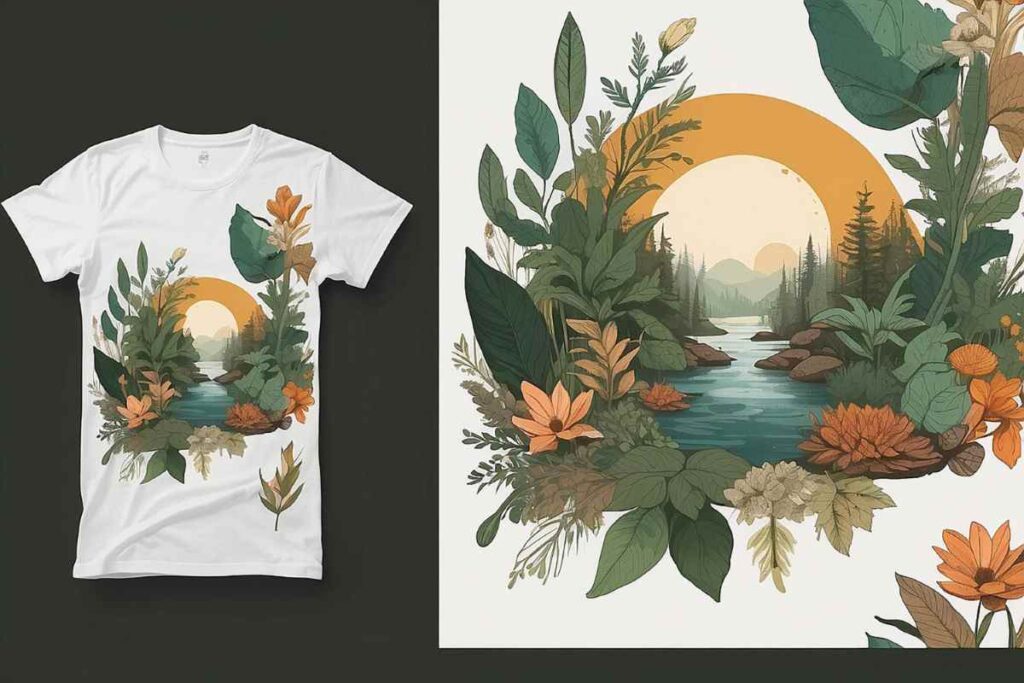DIY DTF transfers have become a must-have for creative enthusiasts, empowering anyone to produce vibrant and personalized designs right at home. With Direct-to-Film (DTF) printing technology, you can effortlessly bring your custom designs to life, ensuring that every piece is unique and tailored to your style. This innovative printing method is not only accessible but also aligns with sustainable printing practices, enabling you to create stunning apparel while being mindful of the environment. As DTF transfer technology evolves, it introduces higher quality outputs and exceptional color accuracy, making your DIY projects stand out. Whether you are a hobbyist or a budding entrepreneur, embracing the world of DIY DTF transfers offers endless possibilities for custom creations that resonate with your personal aesthetic.
Exploring the realm of at-home transfer printing, Direct-to-Film (DTF) methods have revolutionized how designers and crafters approach customization. Often referred to as film transfer printing, this innovative technique utilizes specialized printers to apply vibrant graphics onto various fabrics, opening up new avenues for creative expression. The ease of replicating intricate designs makes it a favored choice among those looking to create unique clothing items. Additionally, this sustainable printing option reduces waste, aligning with the growing demand for eco-friendly production methods in the textile industry. By harnessing DTF technology, individuals can enjoy the dual benefits of artistic freedom and environmental responsibility.
Understanding DTF Printing Technology
DTF printing technology, or Direct-to-Film printing, revolutionizes the custom apparel industry by offering a unique process that allows for vibrant colors and intricate designs. Unlike traditional printing methods, DTF transfers don’t just print ink that sits on top of the fabric; instead, the ink is transferred onto a special film that bonds with the fabric upon heat application. This results in durable designs that maintain their brilliance even after multiple washes, making DTF a preferred choice for those aiming to create long-lasting apparel.
Moreover, the adaptability of DTF printing makes it suitable for a diverse array of fabrics, including cotton, polyester, and their blends. This versatility opens the doors for creators to design custom pieces not just for clothing, but also for home textiles, accessories, and more. With the rise in demand for personalized products, understanding DTF printing becomes essential for hobbyists and small businesses alike, seeking to tap into this growing market.
Benefits of DIY DTF Transfers for Custom Apparel
DIY DTF transfers bring numerous advantages for those interested in creating custom apparel from home. Firstly, it allows individuals to unleash their creativity without the limitations imposed by standard printing methods. Entrepreneurs and craft enthusiasts can experiment with various designs, colors, and materials, bringing their unique artistic visions to life. This freedom not only enhances their personal satisfaction but also gives businesses the flexibility to cater to niche markets with specialized designs.
Another key benefit lies in the cost-effectiveness of DIY DTF transfers. With the initial investment in a quality DTF printer and supplies, users can produce multiple designs on-demand, reducing the need for bulk purchases or inventory storage. This on-demand capability is particularly valuable for small businesses, which can minimize financial risks while maximizing offerings for their customers. Overall, the DIY DTF printing process empowers users to create stunning custom apparel efficiently and economically.
Sustainable Printing Practices with DTF Technology
Sustainability is increasingly crucial in today’s printing industry, and DTF technology stands at the forefront of eco-friendly practices. The process itself minimizes material waste by allowing creators to print exactly what they need for each project, thereby reducing excess fabric and ink usage. Furthermore, many DTF inks are water-based and non-toxic, which are more environmentally friendly compared to their solvent-based counterparts. This makes DTF printing an attractive option for those who want to align their creative endeavors with sustainable practices.
Additionally, the ability to use DTF transfers on a variety of garments promotes a culture of upcycling and creativity. Instead of discarding old clothes, consumers can breathe new life into their wardrobes with custom DTF designs, thereby extending the lifespan of textiles. Engaging in sustainable printing not only benefits the environment but also appeals to a growing audience of environmentally-conscious consumers seeking personalized products that align with their values.
Exploring Design Techniques for DTF Transfers
When embarking on your DIY DTF transfer journey, understanding the design techniques is paramount to achieving impressive results. Start with software like Adobe Illustrator or CorelDRAW, which enable creators to craft detailed illustrations that can be easily manipulated and printed. Incorporating a variety of colors and textures can elevate your design, but it’s crucial to keep in mind the final product’s aesthetic when selecting elements. For instance, contrasting colors can make features pop, while softer palettes may deliver a more subtle effect.
Moreover, exploring different design techniques such as layering and gradients can enhance the depth and richness of your transfers. Remember that your design should not only look good on a screen but must also print well on fabric. Most importantly, always ensure to reverse any text before printing, as DTF transfers adhere to materials in a mirrored fashion. By implementing these design strategies effectively, you’ll create stunning garments that are sure to impress.
Essential Materials for Successful DIY DTF Printing
Successfully creating DTF transfers at home hinges on having the right materials. At the core of this process is a high-quality DTF printer, such as the LOKLiK iPrinter DTF-A3-XP600, which excels at producing vibrant and precise prints. Alongside the printer, DTF transfer film and powder adhesive are crucial components that facilitate the transfer process. The right combination ensures that each design adheres perfectly to the fabric, maintaining its integrity and appearance over time.
In addition to these essential supplies, having proper heat press equipment is fundamental. A heat press machine not only applies the appropriate amount of pressure but also regulates temperature, which is vital for optimal transfer adhesion. Additionally, utilizing the correct design software will further streamline your workflow, enabling you to create and prepare designs efficiently. By assembling the necessary materials, you’ll set yourself up for successful and enjoyable DIY DTF transfer creation.
Advanced Tips for Maximizing DTF Transfer Quality
To achieve stunning results with DIY DTF transfers, it’s important to employ advanced techniques that enhance quality. One of the key tips is ensuring that the fabric you choose for printing is clean and free of any contaminants, such as dirt or oils. Pre-washing fabrics before applying DTF transfers helps to remove any finishes that might hinder adhesion. Additionally, investing in a quality heat press with adjustable temperature settings can aid in achieving the perfect adhesion without damaging the fabric.
Furthermore, experimenting with different pressing times and temperatures can yield improved results based on your specific fabric type. Monitoring the curing process of the DTF powder adhesive is also crucial; it must be completely set to ensure longevity and durability. By refining these techniques, creators can consistently produce high-quality custom designs that withstand the test of time, enhancing their reputation and business success in the DTF printing market.
Frequently Asked Questions
What are DIY DTF Transfers and how do they work?
DIY DTF Transfers involve printing custom designs on special transfer film that can be applied to fabrics using heat and pressure. This process utilizes DTF printing technology to create vibrant, high-quality images that adhere seamlessly to diverse materials, like cotton and polyester.
What materials do I need to create DIY DTF Transfers?
To create DIY DTF Transfers, you’ll need a DTF printer such as the LOKLiK iPrinter DTF-A3-XP600, DTF transfer film, DTF powder adhesive, a heat press machine, design software, and your choice of fabric. These components are essential for producing high-quality custom designs at home.
How sustainable is DTF printing in the context of DIY DTF Transfers?
DTF printing technology is becoming increasingly sustainable, emphasizing waste reduction and resource efficiency. By using eco-friendly practices in the DIY DTF Transfers process, you can create custom designs while minimizing your environmental impact, aligning with modern consumer sustainability goals.
What advantages does DIY DTF Transfer technology offer for custom designs?
DIY DTF Transfer technology offers several advantages, including versatility across various fabric types, cost-effectiveness in producing multiple designs, and superior quality outputs comparable to professional printing services. This enables creators to enjoy artistic freedom with their custom designs.
Can I use a regular printer for DIY DTF Transfers?
No, a regular printer cannot be used for DIY DTF Transfers. You need a specialized DTF printer, like the LOKLiK iPrinter DTF-A3-XP600, that is designed to deliver the quality and vibrancy required for direct-to-film printing, ensuring successful application on fabrics.
What steps should I follow to create my own DTF Transfers at home?
To create DIY DTF Transfers, start by designing your artwork using design software. Print your design on DTF transfer film with your DTF printer, apply DTF powder adhesive, cure under heat, and use a heat press to transfer the design onto your fabric. Follow these steps for stunning results!
| Key Point | Description |
|---|---|
| Introduction | DIY DTF transfers allow for stunning designs to be created at home with accessible printing technology. |
| What are DTF Transfers? | DTF transfers use a special film to print designs that can be transferred to fabric with heat and pressure, offering flexibility and vibrant colors. |
| Key Developments | Current advancements include high-quality printers like the LOKLiK iPrinter DTF-A3-XP600, eco-friendly practices, and market expansion with new product offerings. |
| How to Create DTF Transfers | Essential materials include a DTF printer, transfer film, adhesive, a heat press, design software, and fabric. Follow a detailed step-by-step guide to create your transfers. |
| Benefits of DIY DTF Transfers | DIY DTF transfers are versatile, cost-effective, provide high-quality results, and offer creative freedom in design. |
Summary
DIY DTF transfers offer a remarkable opportunity to create stunning custom designs at home. This innovative printing method has revolutionized the crafting landscape, enabling both hobbyists and small business owners to bring their unique visions to life with vibrant colors and intricate details. With high-quality printers like the LOKLiK iPrinter DTF-A3-XP600 now available and a focus on sustainability in printing, transitioning to DIY DTF transfers is an excellent choice for anyone looking to cultivate their creativity. By following the simple steps and harnessing the right materials, you’re empowered to produce eye-catching apparel tailored to your taste. Embrace the world of DIY DTF transfers today and unlock endless possibilities in custom design!


